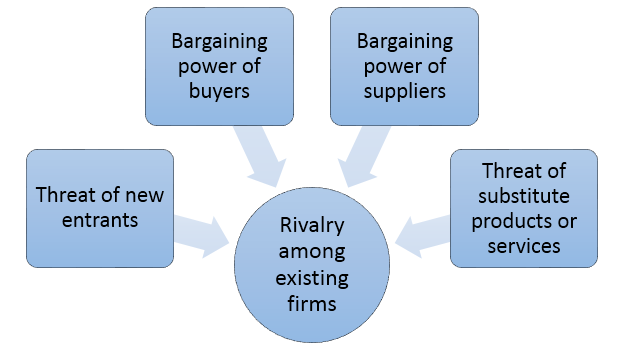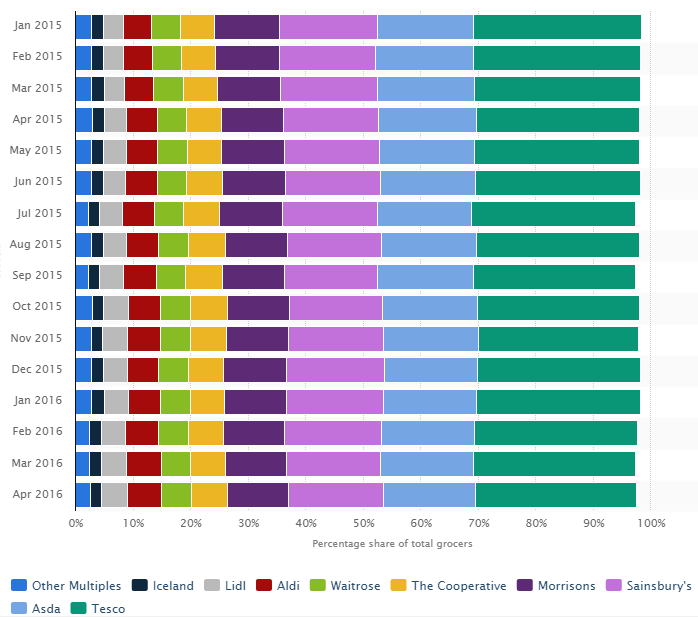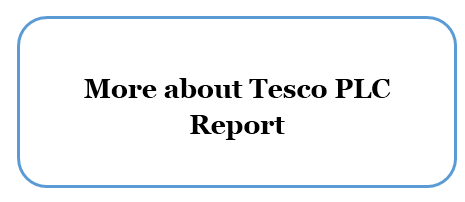Tesco Porter’s Five Forces Analysis
Tesco Porter’s five forces attempts to analyze five separate forces that determine the extent of overall competition in the grocery retail industry. These forces are represented in Figure 1 below:
Figure 1 Tesco Porter’s Five Forces
Threat of substitute products or services for Tesco is irrelevant. Tesco sells a wide range of products belonging to the following categories:
- Clothing & jewelry
- Technology & gaming
- Health & beauty
- Home electrical
- Entertainment & books
- Home appliances
- Baby & toddler
- Garden
- Toys
- DIY & Car
The range of products sold by Tesco is highly comprehensive. The supermarket chain sells a wide range of products, as well as, substitutes of the majority of these products. Therefore, it can be argued that the threat of substitute products and services for Tesco is irrelevant.
Rivalry among existing firms in supermarket chain sector is fierce. The amount of advertising expenditure and the extent of differentiation of products and services are major factors impacting the competitiveness of companies operating in food and grocery retail industry. There are no switching costs for consumers and this fact also increases the intensity of competition in the industry. As it is illustrated in Figure 2 below, although there are many major market players in the grocery retail industry in the UK, Tesco maintains a clear leadership position despite challenges the company currently faces.
Figure 2 Market share of grocery retail chains in the UK from January 2015 to April 2016[1]
Bargaining power of Tesco suppliers is low. Tesco has hundreds of suppliers and there is a minimum or no supplier switching cost for the supermarket chain. The company has the history of using its barraging power to delay payment to suppliers in order to improve its operational profit margins under the previous leadership in 2014.[2] After this and other incidents of poor supplier treatment attracted an extensive media coverage damaging the brand image, the supplier relationship practices have been subjected to an extensive review by the new leadership since October 2015.[3] According to results of a survey conducted by Tesco, only 58 per cent of suppliers indicated that they feel satisfied with their relationship with the company….
Tesco PLC Report contains a full version of Tesco’s Porter’s Five Forces Analysis. The report also illustrates the application of the major analytical strategic frameworks in business studies such as SWOT, PESTEL, Value Chain Analysis and McKinsey 7S Model on Tesco. Moreover, the report contains analysis of Tesco’s marketing strategy, discusses leadership and organizational structure and addresses the issues of corporate social responsibility.
[1] Statista (2016) Available at: http://www.statista.com/statistics/280208/grocery-market-share-in-the-united-kingdom-uk/
[2] Simpson, E. (2016) “Tesco knowingly delayed payments to suppliers” BBC, Available at: http://www.bbc.com/news/business-35408064
[3] Annual Report and Financial Statements (2015) Tesco Plc.



